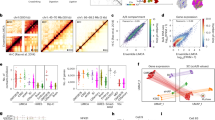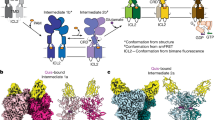Abstract
In neural systems, information is often carried by ensembles of cells rather than by individual units. Optical indicators1 provide a powerful means to reveal such distributed activity, particularly when protein-based and encodable in DNA2,3,4: encodable probes can be introduced into cells, tissues, or transgenic organisms by genetic manipulation, selectively expressed in anatomically or functionally defined groups of cells, and, ideally, recorded in situ, without a requirement for exogenous cofactors. Here we describe sensors for secretion and neurotransmission that fulfil these criteria. We have developed pH-sensitive mutants of green fluorescent protein (‘pHluorins’) by structure-directed combinatorial mutagenesis, with the aim of exploiting the acidic pH inside secretory vesicles5,6 to monitor vesicle exocytosis and recycling. When linked to a vesicle membrane protein, pHluorins were sorted to secretory and synaptic vesicles and reported transmission at individual synaptic boutons, as well as secretion and fusion pore ‘flicker’ of single secretory granules.
This is a preview of subscription content, access via your institution
Access options
Subscribe to this journal
Receive 51 print issues and online access
$199.00 per year
only $3.90 per issue
Buy this article
- Purchase on Springer Link
- Instant access to full article PDF
Prices may be subject to local taxes which are calculated during checkout




Similar content being viewed by others
References
Tsien, R. Y. Fluorescent probes of cell signaling. Annu. Rev. Neurosci. 12, 227–253 (1989).
Miesenböck, G. & Rothman, J. E. Patterns of synaptic activity in neural networks recorded by light emission from synaptolucins. Proc. Natl Acad. Sci. USA 94, 3402–3407 (1997).
Miyawaki, A. et al. Fluorescent indicators for Ca2+ based on green fluorescent proteins and calmodulin. Nature 388, 882–887 (1997).
Romoser, V. A., Hinkle, P. M. & Persechini, A. Detection in living cells of Ca2+-dependent changes in the fluorescence emission of an indicator composed of two green fluorescent protein variants linked by a calmodulin-binding sequence. J. Biol. Chem. 272, 13270–13274 (1997).
Anderson, R. G. & Orci, L. Aview of acidic intracellular compartments. J. Cell Biol. 106, 539–543 (1988).
Südhof, T. C. The synaptic vesicle cycle: a cascade of protein–protein interactions. Nature 375, 645–653 (1995).
Ward, W. W. in Bioluminescence and Chemiluminescence (eds DeLuca, M. A. & McElroy, W. D.) 235–242 (Academic, New York, (1981)).
Ward, W. W., Prentice, H. J., Roth, A. F., Cody, C. W. & Reeves, S. C. Spectral perturbations of the Aequorea green-fluorescent protein. Photochem. Photobiol. 35, 803–808 (1982).
Heim, R., Prasher, D. C. & Tsien, R. Y. Wavelength mutations and posttranslational autoxidation of green fluorescent protein. Proc. Natl Acad. Sci. USA 91, 12501–12504 (1994).
Chattoraj, M., King, B. A., Bublitz, G. U. & Boxer, S. G. Ultra-fast excited state dynamics in green fluorescent protein: Multiple states and proton transfer. Proc. Natl Acad. Sci. USA 93, 8362–8367 (1996).
Ormö, M. et al. Crystal structure of the Aequorea victoria green fluorescent protein. Science 273, 1392–1395 (1996).
Yang, F., Moss, L. G. & Phillips, G. N. J The molecular structure of green fluorescent protein. Nature Biotechnol. 14, 1246–1251 (1996).
Brejc, K. et al. Structural basis for dual excitation and photoisomerization of the Aequorea victoria green fluorescent protein. Proc. Natl Acad. Sci. USA 94, 2306–2311 (1997).
Ehrig, T., O'Kane, D. J. & Prendergast, F. G. Green-fluorescent protein mutants with altered fluorescence excitation spectra. FEBS Lett. 367, 163–166 (1995).
Heim, R. & Tsien, R. Y. Engineering green fluorescent protein for improved brightness, longer wavelengths and fluorescence resonance energy transfer. Curr. Biol. 6, 178–182 (1996).
Caras, I. W., Weddell, G. N., Davitz, M. A., Nussenzweig, V. & Martin, D. W. J Signal for attachment of a phospholipid membrane anchor in decay accelerating factor. Science 238, 1280–1283 (1987).
Luzio, J. P. et al. Identification, sequencing and expression of an integral membrane protein of the trans-Golgi network (TGN38). Biochem. J. 270, 97–102 (1990).
McMahon, H. T. et al. Cellubrevin is a ubiquitous tetanus-toxin substrate homologous to a putative synaptic vesicle fusion protein. Nature 364, 346–349 (1993).
Marconi, P. et al. Replication-defective herpes simplex virus vectors for gene transfer in vivo. Proc. Natl Acad. Sci. USA 93, 11319–11320 (1996).
Lawrence, M. S., Ho, D. Y., Dash, R. & Sapolsky, R. M. Herpes simplex virus vectors overexpressing the glucose transporter gene protect against seizure-induced neuron loss. Proc. Natl Acad. Sci. USA 92, 7247–7251 (1995).
Stevens, C. F. & Tsujimoto, T. Estimates for the pool size of releasable quanta at a single central synapse and for the time required to refill the pool. Proc. Natl Acad. Sci. USA 92, 846–849 (1995).
Roa, M., Paumet, F., Le Mao, J., David, B. & Blank, U. Involvement of the ras-like GTPase rab3d inRBL-2H3 mast cell exocytosis following stimulation via high-affinity IgE receptors (FcεRI). J.Immunol. 159, 2815–2823 (1997).
Fernandez, J. M., Neher, E. & Gomperts, B. D. Capacitance measurements reveal stepwise fusion events in degranulating mast cells. Nature 312, 453–455 (1984).
Chandler, D. E. & Heuser, J. E. Arrest of membrane fusion events in mast cells by quick-freezing. J. Cell Biol. 86, 666–674 (1980).
Ullrich, A. & Schlessinger, J. Signal transduction by receptors with tyrosine kinase activity. Cell 61, 203–212 (1990).
Yu, S. S., Lefkowitz, R. J. & Hausdorff, W. P. β-Adrenergic receptor sequestration: A potential mechanism of receptor resensitization. J. Biol. Chem. 268, 337–341 (1993).
James, D. E. & Piper, R. C. Insulin resistance, diabetes, and the insulin-regulated trafficking of GLUT-4. J. Cell Biol. 126, 1123–1126 (1994).
Siemering, K. R., Golbik, R., Sever, R. & Haseloff, J. Mutations that suppress the thermosensitivity of green fluorescent protein. Curr. Biol. 6, 1653–1663 (1996).
Acknowledgements
We thank R. Miller for technical assistance, D. Krisky and J. Glorioso for HSV strain THZ.3 and 7B cells, G. Schiavo for BoNT, the Fonds de la Recherche en Santé du Québec for a postdoctoral fellowship (to D.A.D.), and Q. Al-Awqati for discussion. This research was supported by the G. Harold and Leila Y. Mathers Charitable Foundation.
Author information
Authors and Affiliations
Rights and permissions
About this article
Cite this article
Miesenböck, G., De Angelis, D. & Rothman, J. Visualizing secretion and synaptic transmission with pH-sensitive green fluorescent proteins. Nature 394, 192–195 (1998). https://doi.org/10.1038/28190
Received:
Accepted:
Published:
Issue Date:
DOI: https://doi.org/10.1038/28190
This article is cited by
-
Cross-modality supervised image restoration enables nanoscale tracking of synaptic plasticity in living mice
Nature Methods (2023)
-
Cell cycle-linked vacuolar pH dynamics regulate amino acid homeostasis and cell growth
Nature Metabolism (2023)
-
Recombinant production of the lantibiotic nisin using Corynebacterium glutamicum in a two-step process
Microbial Cell Factories (2022)
-
Monitoring cell membrane recycling dynamics of proteins using whole-cell fluorescence recovery after photobleaching of pH-sensitive genetic tags
Nature Protocols (2022)
-
Toward implantable devices for angle-sensitive, lens-less, multifluorescent, single-photon lifetime imaging in the brain using Fabry–Perot and absorptive color filters
Light: Science & Applications (2022)
Comments
By submitting a comment you agree to abide by our Terms and Community Guidelines. If you find something abusive or that does not comply with our terms or guidelines please flag it as inappropriate.



